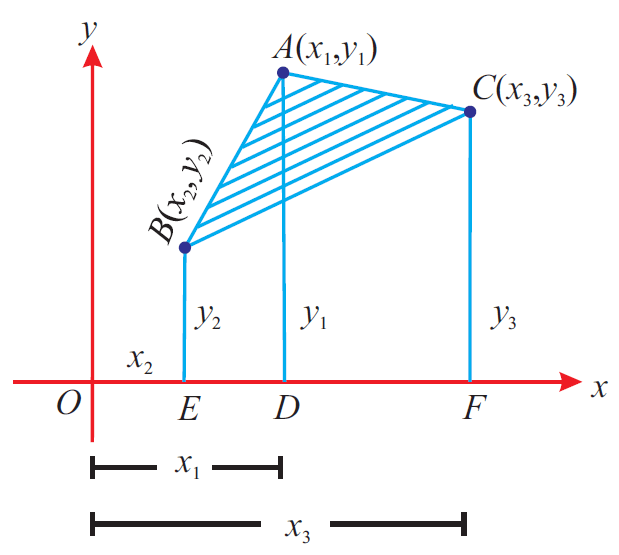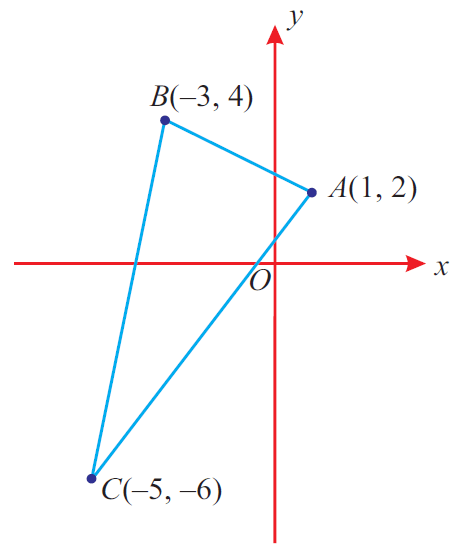AREA OF TRIANGLE WHEN VERTICES ARE GIVEN
Here, we are going to see, how to find area of a triangle when coordinates of the three vertices are given.
Let us consider the triangle given below.

In the above triangle, A(x1, y1), B(x2, y2) and C(x3, y3) are the vertices.
To find area of the triangle ABC, now we have take the vertices A(x1, y1), B(x2, y2) and C(x3, y3) of the triangle ABC in order (counter clockwise direction) and write them column-wise as shown below.

And the diagonal products x1y2, x2y3 and x3y1 as shown in the dark arrows.
Also add the diagonal products x2y1, x3y2 and x1y3 as shown in the dotted arrows.
Now, subtract the latter product from the former product to get area of the triangle ABC.
So, area of the triangle ABC is

Condition for Three Points to be Collinear
Three or more points in a plane are said to be collinear, if they lie on the same straight line.
In other words, three points A(x1, y1), B(x2, y2) and C(x3, y3) are collinear, if any one of these points lies on the straight line joining the other two points.
Suppose that the three points A(x1, y1), B(x2, y2) and C(x3, y3) are collinear, then they can not form a triangle. So, the area of triangle ABC is equal to zero.
That is,
1/2 ⋅ {(x1y2 + x2y3 + x3y1) - (x2y1 + x3y2 + x1y3)} = 0
or
(x1y2 + x2y3 + x3y1 = x2y1 + x3y2 + x1y3
One can prove that the converse is also true.
So, the area of triangle ABC is zero, if and only if the points A, B and C are collinear.
Solved Problems
Problem 1 :
Find the area of the triangle whose vertices are (1, 2), (-3, 4) and (-5, -6)
Solution :
Plot the given points in a rough diagram as given below and take them in order (counter clock wise)

Let the vertices be A(1, 2), B(-3, 4) and C(-5, -6)
Then, we have
(x1, y1) = (1, 2)
(x2, y2) = (-3, 4)
(x3, y3) = (-5, -6)
Area of triangle ABC is
= 1/2 ⋅ {(x1y2 + x2y3 + x3y1) - (x2y1 + x3y2 + x1y3)}
= (1/2) ⋅ {[(1)(4) + (-3)(-6) + (-5)2] - [(-3)2 + (-5)4 + 1(-6)]}
= (1/2) ⋅ { [4 + 18 - 10] - [-6 - 20 -6] }
= (1/2) x { [12] - [-32] }
= (1/2) x { 12 + 32 }
= (1/2) x { 44 }
= 22 square units.
So, area of the triangle ABC is 22 square units.
Problem 2 :
If the area of the triangle ABC is 68 square units and the vertices are A(6, 7), B(-4, 1) and C(a, -9) taken in order, then find the value of "a".
Solution :
Let
(x1, y1) = (6, 7)
(x2, y2) = (-4, 1)
(x3, y3) = (a, -9)
Given : Area of triangle ABC is 68 square units.
Then,
1/2 ⋅ {(x1y2 + x2y3 + x3y1) - (x2y1 + x3y2 + x1y3)} = 68
Multiply each side by 2
{(x1y2 + x2y3 + x3y1) - (x2y1 + x3y2 + x1y3)} = 136
{[6 + 36 + 7a] - [-28 + a - 54]} = 136
[42 + 7a] - [a - 82] = 136
42 + 7a -a +82 = 136
6a + 124 = 136
6a = 12
a = 2
Problem 3 :
Using the concept of area of triangle, show that the points A(5, -2), B(4, -1) and C(1, 2) are collinear.
Solution :
Let
(x1, y1) = (5, -2)
(x2, y2) = (4, -1)
(x3, y3) = (1, 2)
x1y2 + x2y3 + x3y1 = 5(-1) + 4(2) + 1(-2)
x1y2 + x2y3 + x3y1 = -5 + 8 -2
x1y2 + x2y3 + x3y1 = 1 -----(1)
x2y1 + x3y2 + x1y3 = 4(-2) + 1(-1) + 5(2)
x2y1 + x3y2 + x1y3 = -8 -1 + 10
x2y1 + x3y2 + x1y3 = 1 -----(2)
From (1) and (2), we get
x1y2 + x2y3 + x3y1 = x2y1 + x3y2 + x1y3
So, the three points A, B and C are collinear.
Problem 4 :
If P(x, y) is any point on the line segment joining the points (a, 0), and (0, b), then prove that x/a + y/b = 1. where a ≠ b.
Solution :
Clearly, the points (x, y), (a, 0), and (0, b) are collinear.
Then,
area of the triangle = 0
Because area of the triangle is zero, we have
x1y2 + x2y3 + x3y1 = x2y1 + x3y2 + x1y3 -----(1)
Here,
(x1, y1) = (x, y)
(x2, y2) = (a, 0)
(x3, y3) = (0, b)
(1)-----> x ⋅ 0 + a ⋅ b + 0 ⋅ y = a ⋅ y + 0 ⋅ 0 + x ⋅ b
0 + ab + 0 = ay + 0 + xb
ab = ay + xb
Divide each side by ab.
1 = y/b + x/a
or
x/a + y/b = 1
Problem 5 :
If the points (k, -1), (2, 1) and (4, 5) are collinear, then find the value of "k".
Solution :
Because the given points are collinear,
area of triangle = 0
Then, we have
x1y2 + x2y3 + x3y1 = x2y1 + x3y2 + x1y3 -----(1)
Here,
(x1, y1) = (k, -1)
(x2, y2) = (2, 1)
(x3, y3) = (4, 5)
(1)-----> k(1) + 2(5) + 4(-1) = 2(-1) + 4(1) + k(5)
k + 10 - 4 = -2 + 4 + 5k
k + 6 = 2 + 5k
4 = 4k
1 = k
Kindly mail your feedback to v4formath@gmail.com
We always appreciate your feedback.
©All rights reserved. onlinemath4all.com
Recent Articles
-
Digital SAT Math Problems and Solutions (Part - 146)
Apr 18, 25 06:52 AM
Digital SAT Math Problems and Solutions (Part - 146) -
Logarithmic Derivative Problems and Solutions
Apr 16, 25 09:25 PM
Logarithmic Derivative Problems and Solutions -
Digital SAT Math Problems and Solutions (Part - 145)
Apr 16, 25 12:35 PM
Digital SAT Math Problems and Solutions (Part - 145)

